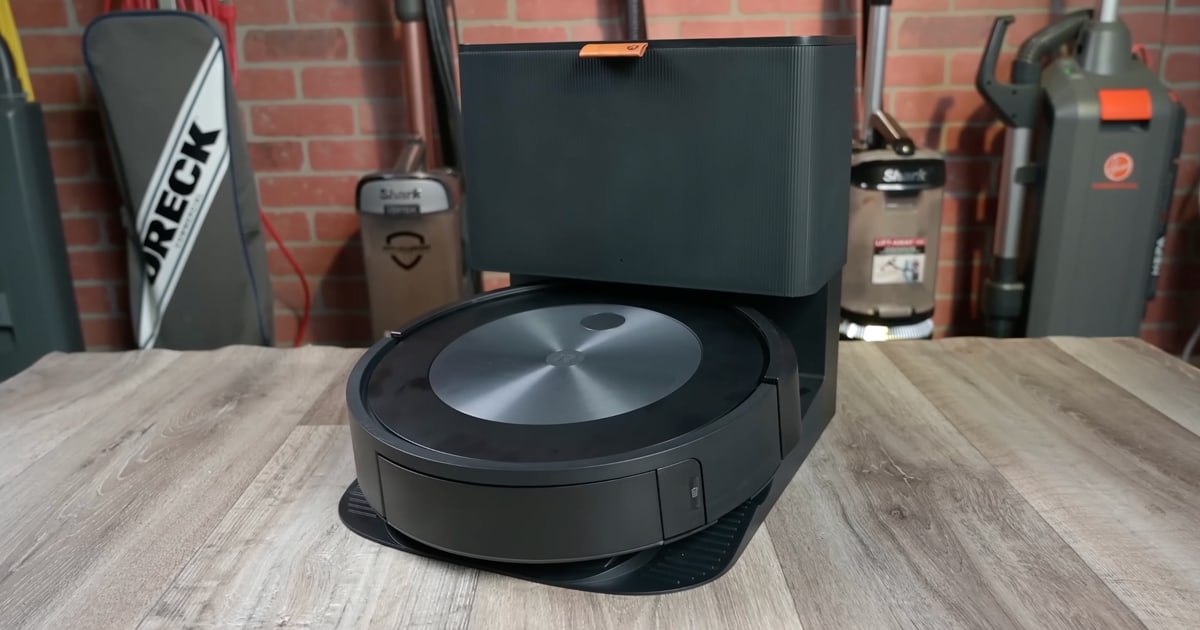Welcome to our iRobot Roomba j7+ review! There are lots of new features and big changes with the j7+ from the previous Roombas. We took a lot of time to test it in various ways to see how everything works and how it compares to other Roombas, as well as to other premium robot vacuums.
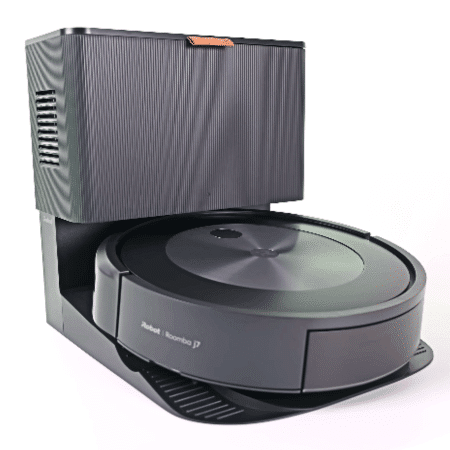
The iRobot Roomba j7+ stands out as the best Roomba to date, delivering a highly refined cleaning experience that blends advanced features with impressive obstacle avoidance—thanks to its new camera-based Precision Vision Navigation—with excellent cleaning performance on both hard floors and carpets. While it has minor drawbacks such as below-average suction power, occasional hair wrapping, and a battery life that could be improved, its smart navigation, intuitive app controls, Keep Out Zones, and the convenience of an auto-empty Clean Base elevate its value as a premium robot vacuum. See additional info
Price as of October 24, 2025
Auto Empty Station: Self Empties Debris
Hardware: 16mm Threshold Crossing
Performance: Dirt Detect
Mapping / Navigation: Multi Level Maps | Virtual Barriers and No Go Zones
Obstacle Avoidance: Unknown Objects Recognized
| Scores | iRobot Roomba j7+ | Average Robot Vacuum Tested |
|---|---|---|
| Vacuum Wars Overall | 1.77 | 2.80 |
| Features | 2.97 | 3.63 |
| Mopping Performance | 0.0 | 2.73 |
| Obstacle Avoidance | 3.75 | 3.44 |
| Pet | 2.83 | 2.87 |
| Navigation | 3.68 | 3.00 |
| Battery | 3.17 | 2.27 |
| Performance | 3.74 | 3.59 |
| Official Battery Life: 90 Minutes | Navigation Type: Single Camera & LED |
| Official Suction Power: Unknown | Dust Bin Size: 250 ml |
| Obstacle Avoidance Type: Floor Tracking | Objects Recognized: Unknown |
| Multi Level Maps: Yes | Virtual Barriers: Yes |
| Detergent Capacity: N/A | Disposable Bag: 2.6L |
About the Roomba j7 and j7+
iRobot released the Roomba j7 and j7+, with the difference being that the plus-designated model includes an auto-empty dock. Following the standard j7s iRobot released the Roomba Combo j7+, which added mopping capabilities.
What we Liked
Let’s get started, starting off with the pros, and there is a long list of them with the Roomba j7+.
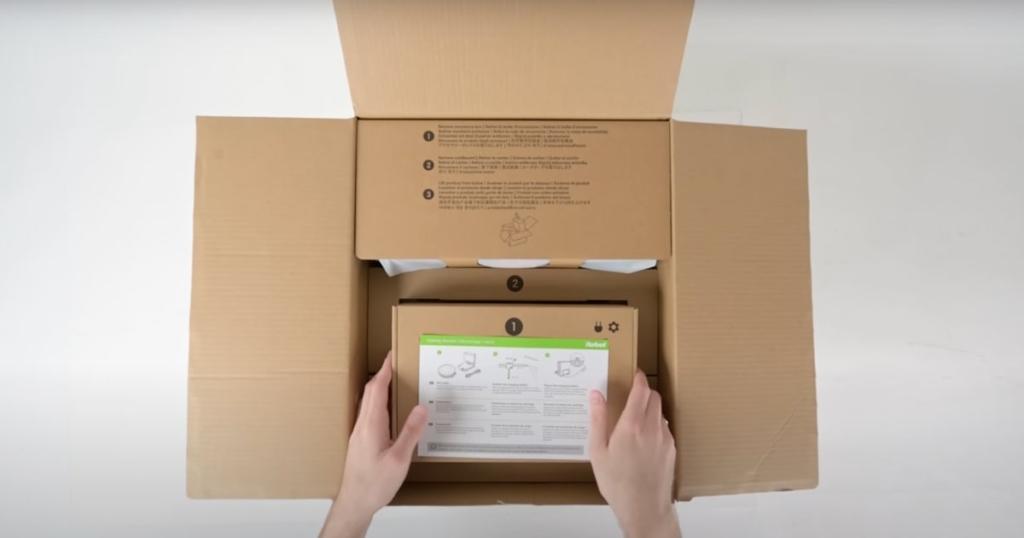
Camera-Based Obstacle Avoidance
The biggest news, in our opinion, is that it’s the first Roomba to have a camera-based obstacle avoidance system, which iRobot calls Precision Vision Navigation. Up until recently, robot vacuums couldn’t detect and avoid objects that were too low for their IR sensors and too light for their bump sensors to recognize, things like cords and socks, and the dreaded pet waste.
The solution was to put some kind of sensor that could detect these kinds of objects on the front of the robot. In the j7+’s case, that is a camera that iRobot has programmed to detect all kinds of objects, and it can learn to avoid even more objects either through updates or its own learning methods.
All in all, it seems to be one of the most well-rounded Roombas we’ve tested.
Obstacle Avoidance Test
Our initial review of the Roomba j7+ was when it was first released. At that time, it was only programmed to recognize cords and pet waste. iRobot noted that future updates to its library would include shoes, socks, and other common household objects.
A visit to the iRoomba website’s support confirmed that the j7 and j7+ can now recognize and avoid cords, wires, cables, pet waste, socks, shoes, slippers, fabrics, clothes, towels, backpacks, pet toys, pet bowls, litter boxes and, this isn’t a joke, pets themselves, specifically cats and dogs.
We tested this in a variety of ways with a variety of objects like toys and cords of all sizes, all of which it recognized and avoided. We also tested this with a lot of pet (novelty) waste.
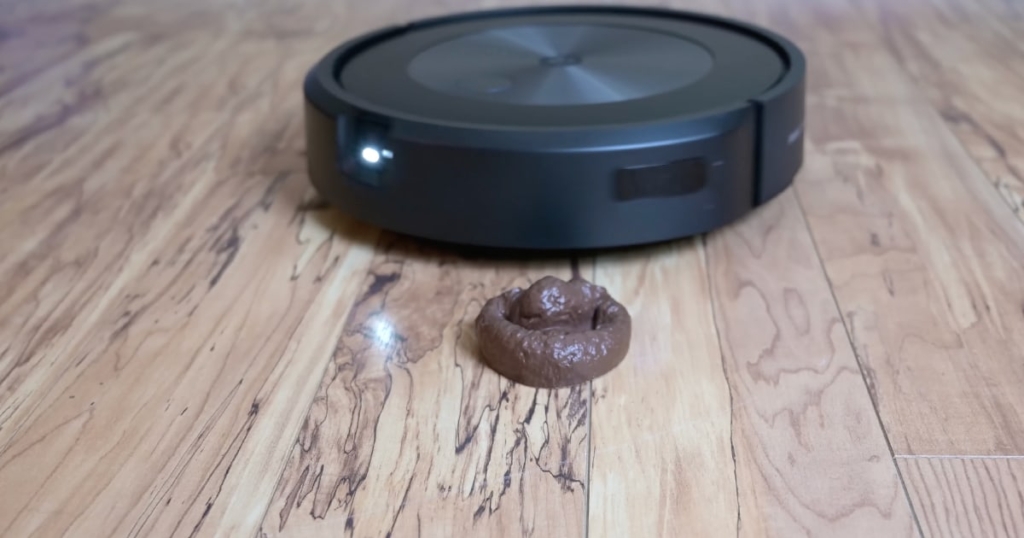
Avoiding Pet Waste
On that point, iRobot seems to have spent a lot of time building models of pet waste for the robot to learn its various shapes and sizes. So much so that they have a new program that seems to more or less guarantee, the j7+ will avoid pet waste. It certainly did perfectly with avoiding it in our test, which is a really big deal.
Not only would it make a huge mess, it effectively ruins the robot. Before this new promise from iRobot, your only consolation would be that you could have a viral video on your hands if you recorded it.
…you really can’t beat a Roomba when it comes to carpet cleaning
Smart Robot Vacuum Features
The Roomba j7+ is a smart robot vacuum, meaning that it creates a map of your house and navigates around very systematically, room by room, in more or less straight lines.
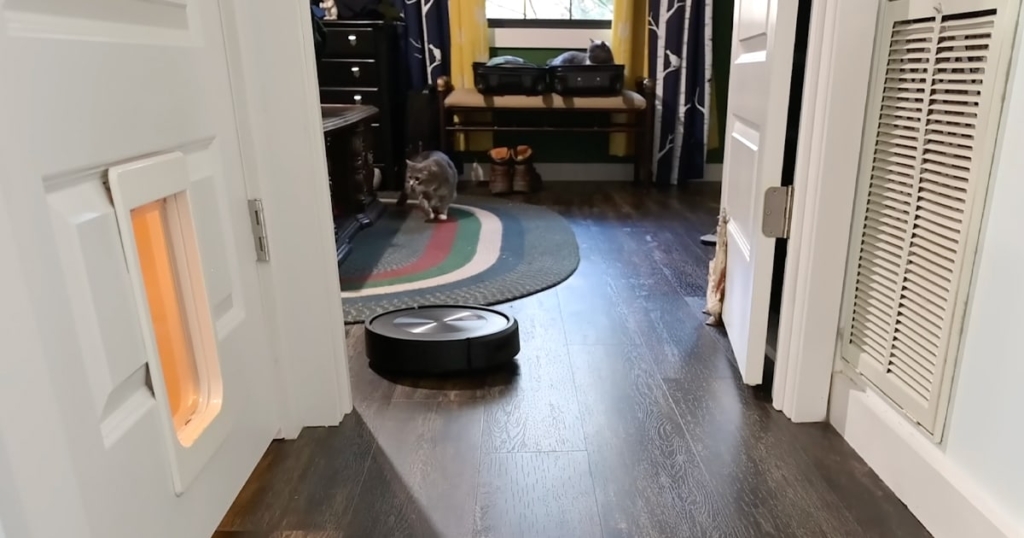
Navigation and Coverage
We were really interested to see how well it did with navigation and coverage. Since the j7+ uses the same camera that it uses for obstacle avoidance for its navigation and it’s mounted on the front instead of on the top, as it has been in the past, it seemed to us like it would be an entirely new navigation algorithm. However, we could tell no difference. Its coverage was as good or better than the previous best Roombas, like the i7+ or the s9+, which is to say, really, really good.
Keep Out Zones
We also really liked the Keep Out Zones feature, where you draw barriers on the app to keep the robot from going places in your house that you don’t want it to go. This is one of our favorite features that we use all the time, and again, it was just as good as the previous top-of-the-line Roombas in the tests.
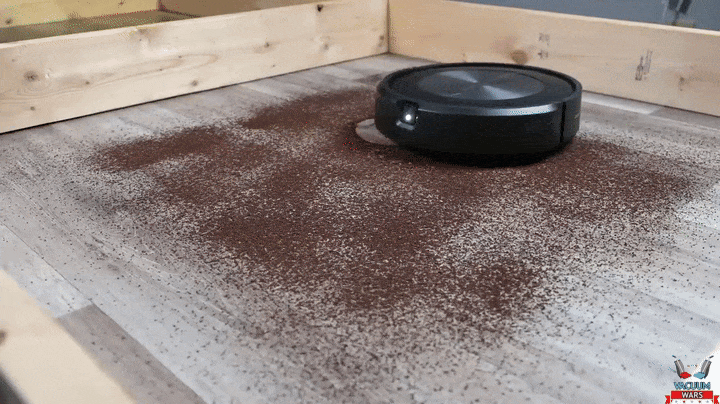
Cleaning Ability
In terms of its cleaning ability, let’s first consider its hardware. It has the new style dual brush design, which we think first came out on the 900 series, with rubberized brushes, one side brush, six drop sensors, and a floor tracker. The two brushes work well together on both hard floors and carpets.
It does well with debris from fine to extra large, and the side brush doesn’t scatter debris as much with these new versions, which we like.
In the box
On carpets, the j7+ is about as good as you’d want a robot vacuum to be. We’ve said many times you really can’t beat a Roomba when it comes to carpet cleaning, mostly because of its patented two-brushroll design.
Carpet Deep Clean Test
On the Carpet Deep Clean Test, where we embed sand into medium pile carpet and weigh the bin before and after a five-minute run, it scored a 91, which is way above average and second only to the Roomba s9+, which is impressive in itself. Since the j7+ got such a high score with a fraction of the energy output, as we will see later, we also think the j7+ was better than the average for hard floors.
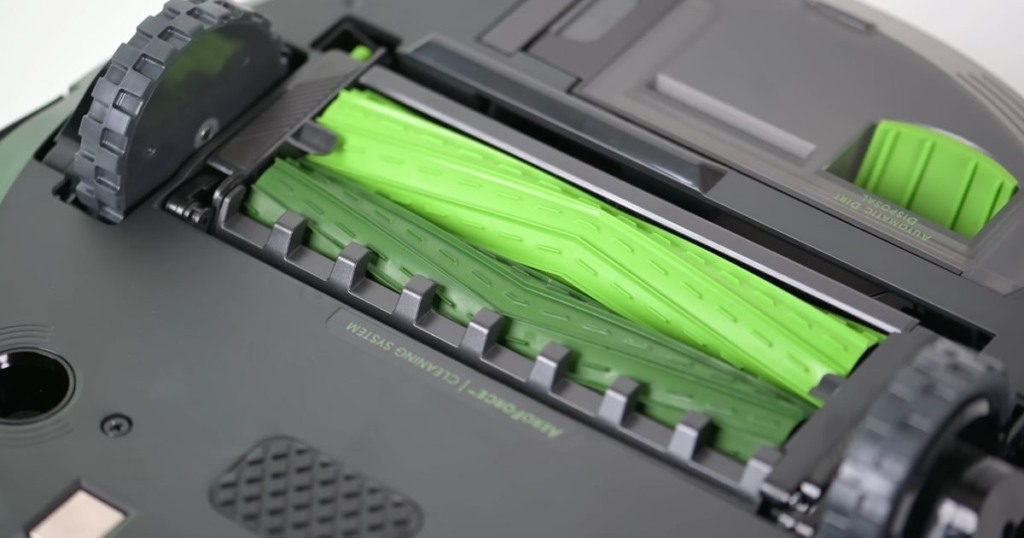
Hard Floors Test
It had a really nice clean pickup of everything from fine to extra-large debris, even heavy debris on hard floors, which is a difficult test. Debris we tested included cereal, sand, coffee grounds and kitty litter. All in all, it seems to be one of the most well-rounded Roombas we’ve tested.
iRobot Roomba Clean Base
Let’s talk about this new iRobot Clean Base. One of our favorite features in the robot vacuum world is these new self-empty bins, where a motor in the base sucks the debris out of the robot’s dustbin into an included bag. In iRobot’s case, they say these bags don’t need changing for months on end, depending on your usage. This new design is more compact, with the idea being that it can be put in more places than the older style, like under tables.
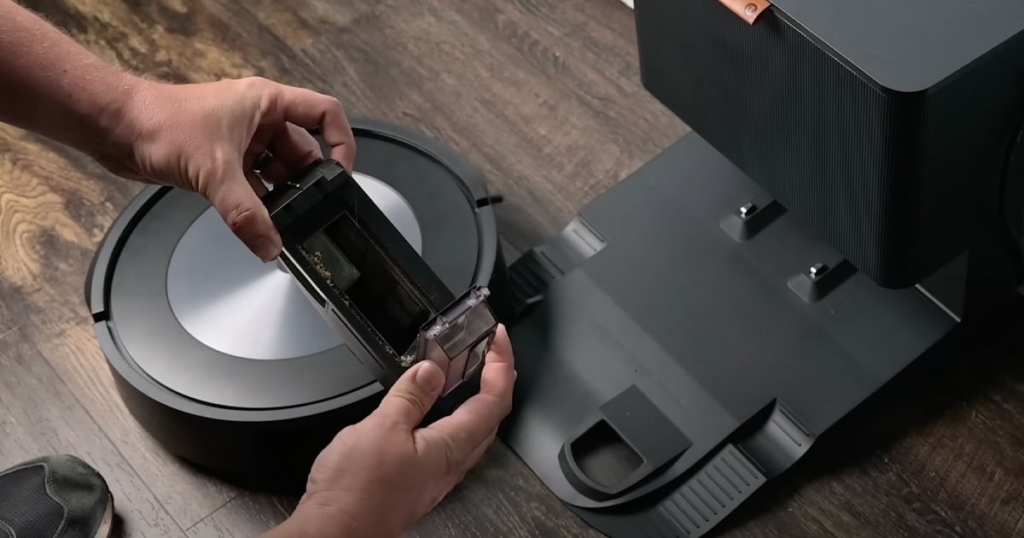
Super Quiet and Low
We like that it was super quiet, around 61 decibels on its one power setting, which is very close to the quietest robot vacuum we’ve ever tested. We also like that it was really short so that it could get under all the furniture we wanted it to.
App Features
One thing that iRobot has clearly invested a lot in is the digital experiences with the iRobot app. Some of these features we’ve seen before and some of these are new to us and unique to premium Roombas like the j7+. We’ve listed a handful of those below, but there is a lot packed into the iRobot Genius 3.0 software system though we didn’t have a chance to test it all out.
Selected App Features – iRobot Genius 3.0
- Clean specific areas of a room (in the app or with voice commands)
- Learn regular cleaning times and recommend schedules
- Clean specific rooms but not others
- Recognize and clean when no one is home
- Map coaching tutorial system
- Cleaning time estimates in the app
- Quiet Drive turns off suction when moving to a new area
- Send pictures of obstacles (if enabled) and ask how to classify objects like them in the future
- Imprint Link Technology coordinates cleaning with Bravva mopping robots
What Could Be Improved
Suction Power
Moving on to the negative stuff, the first thing was the power. With the exception of the Roomba s9+, we found almost all Roombas to score very low on these types of tests, and the j7+ was no exception—very low suction and airflow numbers relative to other robot vacuums we’ve tested.
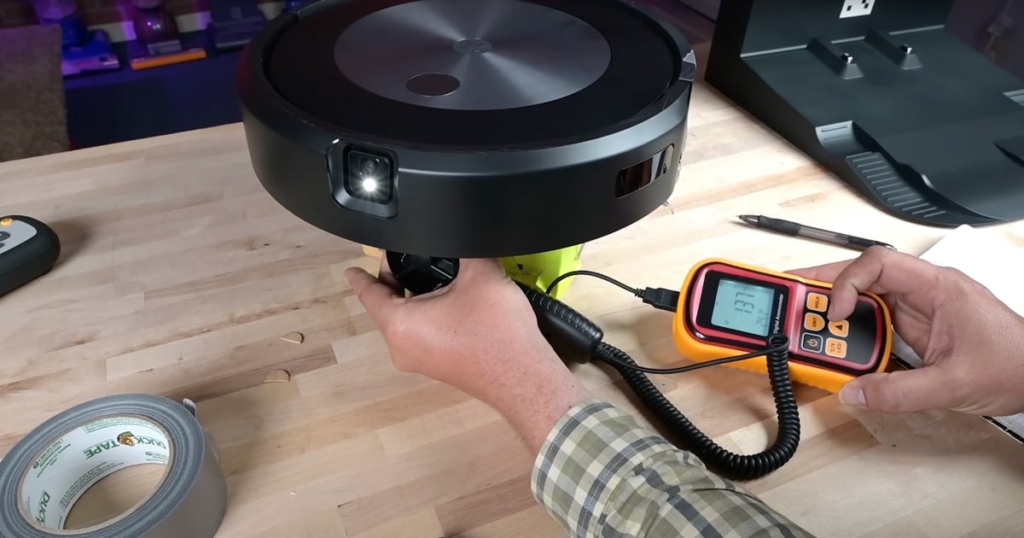
But, the thing is, Roombas are the only vacuums that don’t really need a lot of power since they have that aforementioned two-brushroll design. Which, as we’ve seen, gives them above-average scores with their cleaning ability.
Really the only test in which power was an issue was the crevice pickup test, where it was below average, as have been all the Roombas we’ve tested, with the exception of the s9. But vacuum debris in deep crevices really isn’t something most people will encounter.

Hair Wrapping Around the Brushroll
With the longer human hair tests, the j7 was below average, with a lot of hair getting caught in the axles and some kind of bunched up to the side, which was never picked up. It wasn’t a huge deal, but the thing to remember is to regularly clean the brushroll as a part of regularly scheduled maintenance.
Battery Life
Another negative is that battery life hasn’t really changed much since the Roomba i7 model. iRobot says the j7 can get 75 minutes before needing to recharge, which is decent. It did map the test house with time to spare, so it’s not a huge deal, but 75 minutes is below average for a premium robot, especially robots that don’t have a lot of power. So, a bigger battery would have been nice.
Price
The price is also a negative, but really just because it’s a premium price. It is trending in the right direction, though. The j7+ is quite a bit cheaper than the s9+ was when it was released, and we like the j7+ a lot more than we like the s9+.
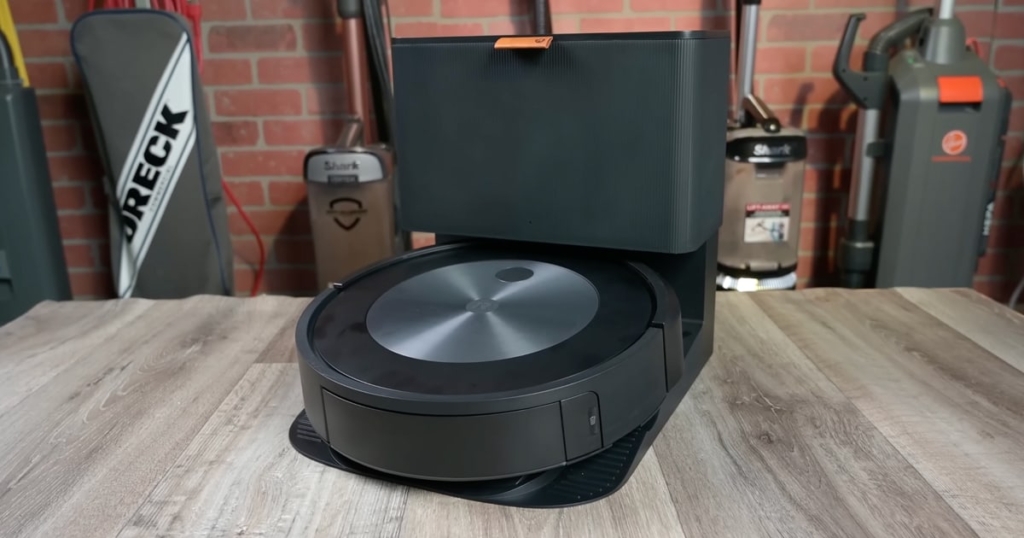
Verdict: Best Roomba Vacuuming Robot to Date!
To sum it all up, we think there’s no question that the j7+ is the best Roomba from iRobot to date. It did all the things it needed to do really well, like clean hard floors and carpet, but the premium features like the Clean Base and the obstacle avoidance sensors take it to the next level in terms of value. These features are very useful when combined with things like the Keep Out Zones and all the app features in Genius 3.0.
